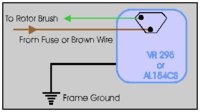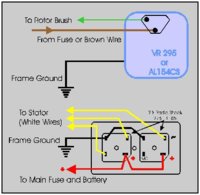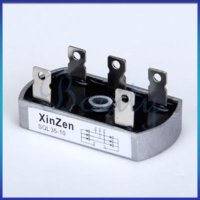Mine said RZ 296 or R 296 Z. Either way they work well.
For a rectifier, on mine I used a pair of rectifiers from Radio Shack. They are single phase and you need two. I'll post a wiring diagram. You can see that the two are linked at the outputs, Leaving one set of AC inputs unused.
With them having the issues they are having it's not such a good thing.
The last rectifiers I got were off Ebay. Search for three phase rectifiers. Get one with about a 25 amp rating, most are rated a minimum of 1000 volts. Any bigger is just more money spent. A bit easier to wire, no linking two together. The three whites hook to the three terminals with wavy lines. The red out put to the + terminal, Black to the - terminal.
I'll post a pic. In the pic you can see three terminals on one side, these are the AC inputs, the two on the other side are the DC outputs.
A bit less wiring. I think I paid around $3 or $4 each for the ones of Ebay, the Radio Shack ones were $3.58 each or $7.16.
So a bit cheaper and a bit easier to wire.
The Ebay ones I got Have a alloy body so you might not need to much of a heat sink. Just the one through hole for mounting, The Radio Shack ones need a heat sink, A scrap of alloy about 2x3 inches or so 1/8 inch thick. It won't hurt on the Ebay one.
I mounted the Radio shack rectifier on the plate with one bolt in the center to mount it on the original place on the battery box. The regulator I used one mount hole of the original then drilled the other through the battery box.
You need to ground the reg. The battery box if mounted in rubber won't be a ground. Run a wire from under one mount bolt to a good ground.
Leo



